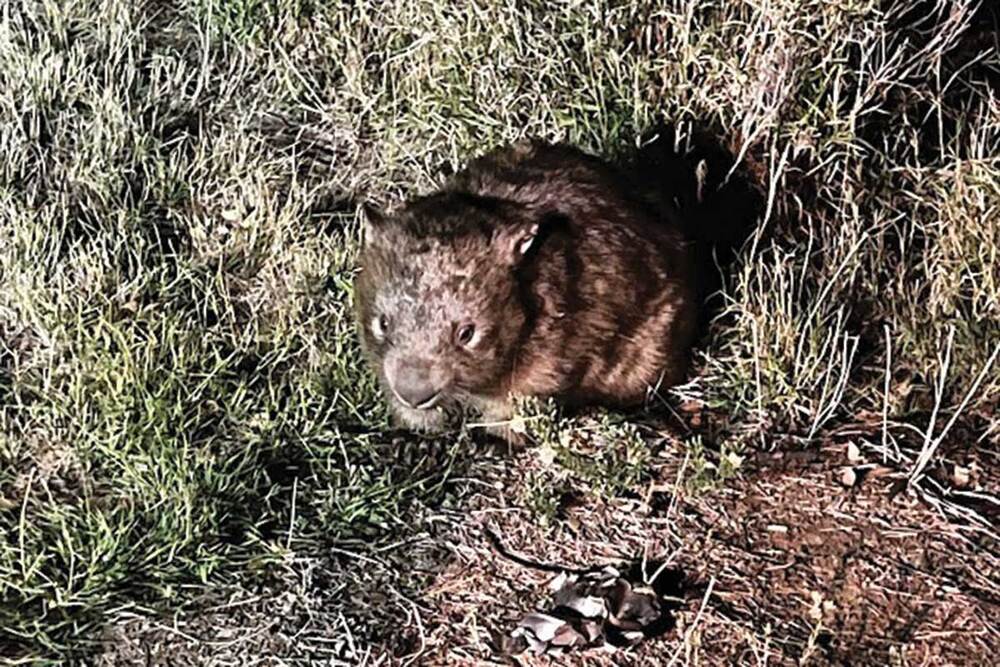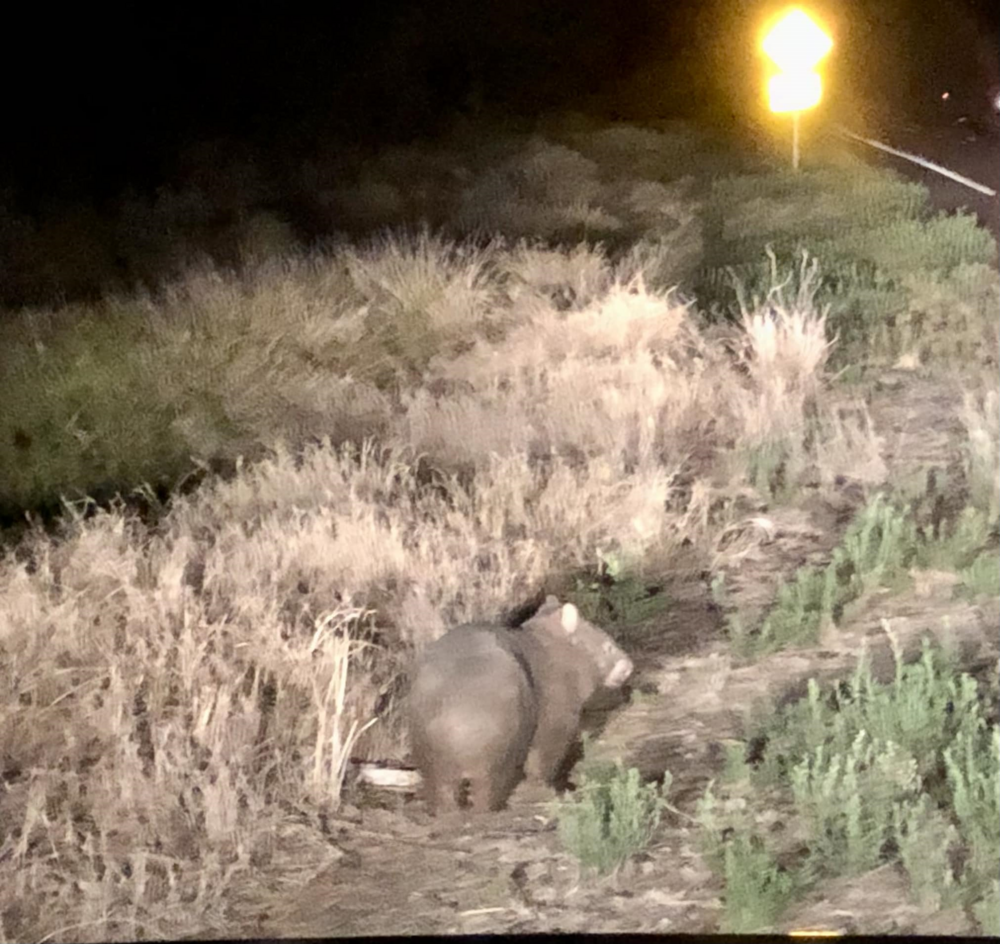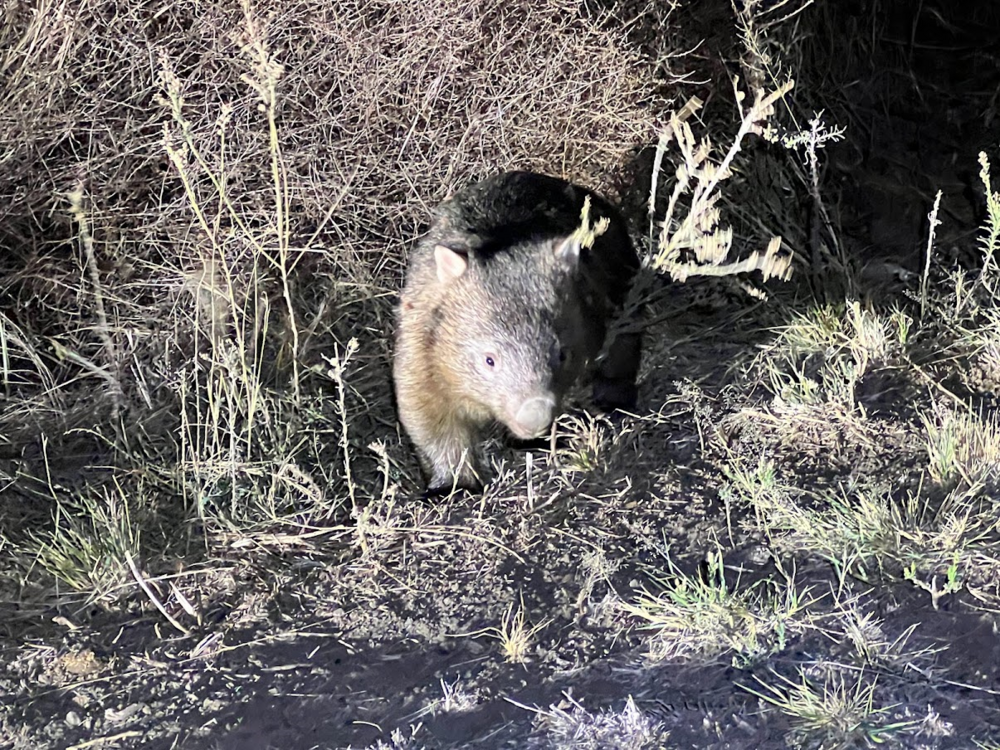Are wombats moving west?
Coonamble Times
15 June 2023, 7:40 AM
 A Wingadee wombat snapped beside the Walgett Road at 7:20pm on 9 May. PHOTOS: Adam Firth
A Wingadee wombat snapped beside the Walgett Road at 7:20pm on 9 May. PHOTOS: Adam FirthSpeculation that more than one wombat might have moved in to the Coonamble area seems to have been confirmed.
Local electrical contractor Adam Firth has sent in photos and video footage of two separate sightings which show distinctively different wombats in very different locations - with the images being geo-located and date and time stamped.
The latest sightings follow occasional reports of a wombat seen and photographed by different people in the Wingadee area between Walgett and Coonamble since New Year's Eve.
“I saw the first one on the 9th May out on the Walgett Road,” Mr Firth said. “And then I saw another one on 23 May out on the Quambone Road.
"I got within three to five metres of them,” he said. “They are similar sized wombats and they both look pretty healthy.”
Conex owner Dean Murray has reported multiple sightings of wombats between Coonamble and Walgett and has welcomed the verification.
“I saw one several times around the same place, at about 5 o’clock in the morning every time,” he said.
“Then I saw another one a fair bit further out at around 7pm one night.”
“Everyone thought I was mad when I first saw them.”
Mr Murray says he’s convinced that there are multiple wombats in that area.

ABOVE: A west-side wombat snapped at around 6.35pm on 23 May on the Quambone Road.
“They’re hard to see when they’re walking along, they just look like a dark bush,” he said.
“There’d be more around - like if you think you’ve got a couple of kangaroos in your paddock you’ll always have more.”
Although he’s had several sightings Dean says he’s still surprised.
“We’ve gone years and not seen any. Dad (Rick) had never seen them around here till recently,” he said. “There’s definitely more than one or two of them.”
In 2014, local farmer Adam Macrae and his children photographed a dead wombat beside the Castlereagh Highway about twenty kilometres from Coonamble.
And on 22 April 2023 he saw a live version.
"It was 4:30 in the morning and he was crossing the highway about sixty kilometres from Walgett," he said.
"To start off with I thought he was a good-sized pig. He was just walking along," Mr Macrae said.
He described the wombat as being about 40 to 50 centimetres high and weighing around 50 kilograms.
On New Year's Eve 2022, another resident Cassie Andrews grabbed some night-time photos of what she initially thought "was a massive pig" also along the Walgett Road.

Wombat snapped by Cassie Andrews on New Years Eve 2022.
This followed reports in mid 2021, of another large wombat that had taken up residence south of Coonamble in the Combara area.
It was spotted between June and August on both sides of the Castlereagh River, including on the highway around 15 kilometres south of the township.
It met a sad end on around the 18 August, most likely hit by a vehicle.
Road accidents aside, wombats can clearly live in our area, so ecologists are now asking whether these are just isolated incidents or whether the range of these chunky marsupials is expanding westward.
They have been known to live in the Warrumbungles and have been reported by farmers in the Binnaway and Mendooran areas.
"It's very unusual," a National Parks & Wildlife representative told the Coonamble Times. "I've been in Coonabarabran for five years and I've never seen one."
"It probably started because of the weather conditions over the last few years. The soils would be significantly softer and they need to be able to burrow into a bank that's stable," he said.
Joey Clarke, from the Australian Wildlife Conservancy (AWC) says Coonamble is right on the edge of a region where there have been a few scattered records of wombats, including a report in the Pilliga in 2019.
From the photographs supplied, both identified the animals as the Common Wombat, also called the Bare-nosed Wombat for identification purposes and by those wanting to emphasise that they are not as 'common' as they used to be.
The other two species are much rarer.

The Northern Hairy Nosed Wombat, which was indigenous to our region pre-European settlement, has been reduced to around 300 known individuals in the Claremont - Emerald area of Queensland.
The AWC is currently working with the Queensland Government to protect the population.
"They have been absolutely decimated and are on the brink of extinction," Mr Clarke said. "It's at the point where they are completely reliant on people for their survival."
The Southern Hairy Nosed wombat is also listed as endangered and is also very rare in NSW.
While the Common Wombat is well known in areas like the Southern Highlands of NSW, increasing development and the prevalence of the skin disease 'sarcoptic mange' may well be pushing them inland.
None of the Coonamble sightings have been officially recorded, making it hard to know for sure how many wombats may be in the area.

Photo Adam Firth
"Is it a population of low density or are they increasingly moving into new areas?," Mr Clarke said.
"You wonder what else people have seen."
Mr Clarke encourages people to report sightings of live - or dead - wombats by contacting the Australian Museum or using an online platform called i-naturalist which can also collect the GPS location from photographs.
All wombats are protected under the NSW Biodiversity Conservation Act 2016. It is an offence to harm a wombat unless a licence is obtained from the Department of Planning and Environment.
If you're in the western plains and have seen a wombat Contact Us - we'd love to hear about it.



